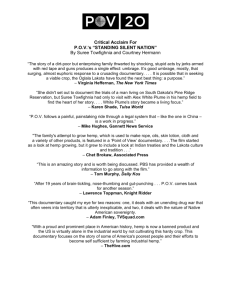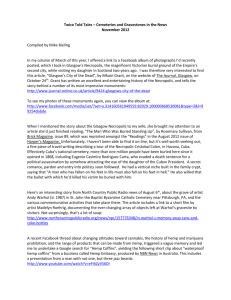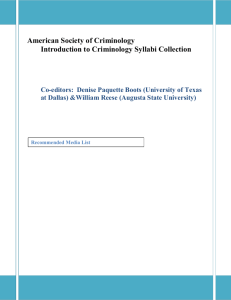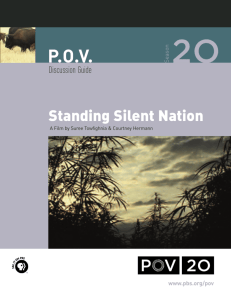Standing Silent Nation
advertisement
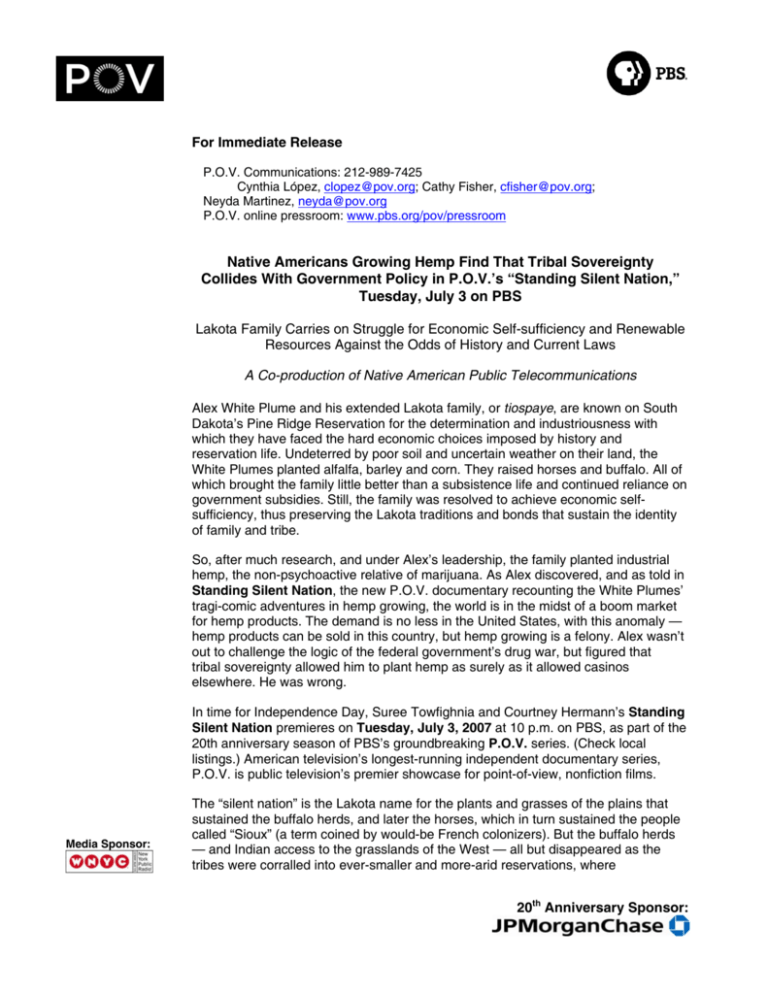
For Immediate Release P.O.V. Communications: 212-989-7425 Cynthia López, clopez@pov.org; Cathy Fisher, cfisher@pov.org; Neyda Martinez, neyda@pov.org P.O.V. online pressroom: www.pbs.org/pov/pressroom Native Americans Growing Hemp Find That Tribal Sovereignty Collides With Government Policy in P.O.V.’s “Standing Silent Nation,” Tuesday, July 3 on PBS Lakota Family Carries on Struggle for Economic Self-sufficiency and Renewable Resources Against the Odds of History and Current Laws A Co-production of Native American Public Telecommunications Alex White Plume and his extended Lakota family, or tiospaye, are known on South Dakota’s Pine Ridge Reservation for the determination and industriousness with which they have faced the hard economic choices imposed by history and reservation life. Undeterred by poor soil and uncertain weather on their land, the White Plumes planted alfalfa, barley and corn. They raised horses and buffalo. All of which brought the family little better than a subsistence life and continued reliance on government subsidies. Still, the family was resolved to achieve economic selfsufficiency, thus preserving the Lakota traditions and bonds that sustain the identity of family and tribe. So, after much research, and under Alex’s leadership, the family planted industrial hemp, the non-psychoactive relative of marijuana. As Alex discovered, and as told in Standing Silent Nation, the new P.O.V. documentary recounting the White Plumes’ tragi-comic adventures in hemp growing, the world is in the midst of a boom market for hemp products. The demand is no less in the United States, with this anomaly — hemp products can be sold in this country, but hemp growing is a felony. Alex wasn’t out to challenge the logic of the federal government’s drug war, but figured that tribal sovereignty allowed him to plant hemp as surely as it allowed casinos elsewhere. He was wrong. In time for Independence Day, Suree Towfighnia and Courtney Hermann’s Standing Silent Nation premieres on Tuesday, July 3, 2007 at 10 p.m. on PBS, as part of the 20th anniversary season of PBS’s groundbreaking P.O.V. series. (Check local listings.) American television’s longest-running independent documentary series, P.O.V. is public television’s premier showcase for point-of-view, nonfiction films. Media Sponsor: The “silent nation” is the Lakota name for the plants and grasses of the plains that sustained the buffalo herds, and later the horses, which in turn sustained the people called “Sioux” (a term coined by would-be French colonizers). But the buffalo herds — and Indian access to the grasslands of the West — all but disappeared as the tribes were corralled into ever-smaller and more-arid reservations, where 20th Anniversary Sponsor: government-issued corn could not thrive and grazing lands were too poor to support herds. This is the history behind Pine Ridge, whose name is also synonymous with Native American resistance to American dominance, from the 1890 Wounded Knee Massacre to 1971’s “Wounded Knee” standoff between the FBI and the American Indian Movement (AIM) to the 1975 Pine Ridge Shootout — and with Lakota persistence in preserving tribal life. Inevitably the harsh realities of reservation economies — or lack of them — are true of Pine Ridge. Only 84,000 of the reservation’s 2 million acres are suitable for agriculture. Unemployment runs as high as 85 percent. Sixty-six percent of the people live in substandard housing. Life expectancy on Pine Ridge is among the lowest in the Western Hemisphere — 47 to 56 years. But Standing Silent Nation finds both resistance and persistence alive on Pine Ridge, especially among the White Plumes, whose goal is to free themselves of dependence on the federal government. The family’s land grant at Pine Ridge may be a rough patch of the sacred earth, but they know that to maintain the tiospaye — to remain Lakota — they must regain their self-sufficiency. In hemp, the White Plumes surely found the perfect “silent nation” ally, a plant whose hardiness, utility and low cost had already been proven by the government who encouraged its growth during its “Hemp for Victory” campaign during World War II. With a fast 120-day growing cycle and no need for expensive or toxic chemicals to flourish, hemp is a boon to the environment whenever it is used in paper or wood products. It is so tough that even on the semi-arid land of Pine Ridge — as events were to prove — it is almost impossible to eradicate once planted. Most of all, soaring domestic and world demand for industrial hemp as forests shrink and the cost of wood rises, makes hemp a “ready cash crop.” Fortified by this economic logic and believing himself protected by tribal sovereignty, Alex White Plume also relied on some readily available information. Not only does industrial hemp lack marijuana’s psychoactive THC element, its presence quickly dilutes the potency of any marijuana plants nearby. If anything, hemp growing would tend to crowd out pot growing. Yet Alex could hardly be unaware of the federal government’s well-publicized drive against all things even tangentially related to marijuana. So what happened was both a surprise and not. As Standing Silent Nation relates, the Oglala Sioux Tribe passed an ordinance in 1998 allowing the cultivation of low-THC hemp on the reservation, which they distinguished from higher-THC marijuana. In April 2000, the White Plumes planted their first crop. In a surprise attack on August 24, 2000 at 6 a.m., federal agents, armed with guns and weed-wackers, chopped the plants down in the same manner they would use to eradicate marijuana. This event, and others that followed, raises a number of questions: Why did the government wait for the first crop to reach maturity before acting? Why did FBI and DEA agents raid the fields at daybreak with an array of armor and guns? Why have they continued to raid the White Plumes’ land, even when the hemp grew back of its own accord, and to bring charges that could put Alex in prison for as long as 10 years? What lies behind the government’s persistent objection to hemp? Should the growing of hemp fall into the same class of crimes as murder, which allows the federal government to override tribal sovereignty? This is the question that matters most to the White Plumes and the other Lakota of Pine Ridge, for whom sovereignty is the last, if much transgressed, defense for Native American rights. Unfortunately, no one from the Drug Enforcement Administration was permitted to explain to the filmmakers the reasoning behind the government’s actions. Standing Silent Nation, shot over the course of four years, is an eye-opening account of reservation life that belies popular images of casino mini-states. It is the story of one Lakota family’s struggle to retain tribal identity and sovereignty against the odds of history and current government policy. “Our purpose in visiting the Pine Ridge Reservation was to meet Alex White Plume, the first person to grow industrial hemp within the boundaries of the United States in over 40 years, and to document his harvest celebration,” says director Suree Towfighnia. “When the crew arrived on August 10, 2002 and we first met Alex, he apologized for being in a bad mood on such a beautiful morning. Ten minutes before, federal agents had served him with a summons that detailed eight federal civil charges filed against him by the U.S. District Attorney. I asked if we could put a microphone on him. He agreed and we started filming.” “The film originally dealt with the American farm community’s right to grow industrial hemp,” says producer Courtney Hermann. “As Alex’s story unfolded, our focus shifted. We now see hemp as a vehicle through which a larger and arguably more important issue is playing out — the sovereignty of the Lakota Nation.” Standing Silent Nation is a production of Prairie Dust Films in association with Native American Public Telecommunications (NAPT). About the filmmakers: Suree Towfighnia Director Suree Towfighnia is an independent filmmaker and freelance director living in Chicago. A recipient of the 2004 Studs Terkel scholarship from the Community Media Workshop, she earned her masters in fine arts degree in documentary filmmaking at Columbia College, Chicago, where she and Courtney Hermann worked as co-technical coordinators of the Michael Rabiger Center for Documentary. Her thesis film, “Tampico” (2006), chronicles a woman’s struggle to survive by playing her family’s music in the subways of Chicago. Towfighnia teaches media making to youth and teens and is a partner, with Courtney Hermann, in Chicago-based Prairie Dust Films. Courtney Hermann Producer Courtney Hermann is an independent documentary filmmaker and educator from Portland, Ore. She recently received the Outstanding Faculty Award at the Art Institute of Portland, where she is an instructor in the Digital Film and Video Department. Hermann has produced and directed several short documentaries, including “Granite Janet” (2000), nominated for the International Documentary Association’s David L. Wolper Award. She earned a master of fine arts degree in film and video production from Columbia College, Chicago, where she and Suree Towfighnia worked as co-technical coordinators of the Michael Rabiger Center for Documentary. Her most recent documentary is “Left on Wild Road” (a work in progress) about the last days of the Exotic World Burlesque Museum, an old Route 66 roadside attraction. Credits: Director: Producer: Cinematographer: Editor: Suree Towfighnia Courtney Hermann Suree Towfighnia Sharon Karp Running Time: 56:46 Awards & Festivals: • Palm Springs Native American Film Festival, 2007 • Native Voice Film Festival, Rapid City, S.D., 2006 Native American Public Telecommunications (NAPT) is one of five national consortia chartered by the Corporation for Public Broadcasting (CPB) to provide minority programming to the public broadcasting system. For 30 years, NAPT has supported the creation, promotion and distribution of Native public media. NAPT support has made it possible to bring to the PBS audience such quality programs as Indian Country Diaries, The Great American Foot Race, Storytellers of the Pacific, In the Light of Reverence, and many others. More information about NAPT is available at www.nativetelecom.org. Other award-winning services of NAPT include the AIROS Native Network, www.airos.org, and Visionmaker Video, www.visionmaker.org, distributor of authentic documentaries by and about Native Americans. NAPT receives major support from CPB and the Ford Foundation. Produced by American Documentary, Inc. and celebrating its 20th season on PBS in 2007, the award-winning P.O.V. series is the longest-running showcase on television to feature the work of America's best contemporary-issue independent filmmakers. Airing Tuesdays at 10 p.m., June through September, with primetime specials during the year, P.O.V. has brought nearly 250 award-winning documentaries to millions nationwide, and now has a Webby Award-winning online series, P.O.V.'s Borders. Since 1988, P.O.V. has pioneered the art of presentation and outreach using independent nonfiction media to build new communities in conversation about today's most pressing social issues. More information about P.O.V is available online at www.pbs.org/pov. P.O.V. Interactive (www.pbs.org/pov) P.O.V.'s award-winning Web department produces special features for every P.O.V. presentation, extending the life of P.O.V. films through filmmaker interviews, story updates, podcasts, streaming video, and community-based and educational content that involves viewers in activities and feedback. P.O.V. Interactive produces our Web-only showcase for interactive storytelling, P.O.V.’s Borders. In addition, www.pbs.org/pov houses Talking Back, where viewers can comment on P.O.V. programs, engage in dialogue and link to further resources. The P.O.V. Web site and P.O.V. archives, including special sites from previous broadcasts, form a unique and extensive online resource for documentary storytelling. P.O.V. Community Engagement and Education P.O.V. provides Discussion Guides for all films as well as curriculum-based P.O.V. Lesson Plans for select films to promote the use of independent media among varied constituencies. Available free online, these original materials ensure the ongoing use of P.O.V.’s documentaries with educators, community workers, opinion leaders and general audiences. P.O.V. works closely with local PBS stations to partner with museums, libraries, schools and community-based organizations to raise awareness of the issues in P.O.V.’s films. P.O.V.’s Youth Views expands these efforts by working with youth-service organizations. Major funding for P.O.V. is provided by the John D. and Catherine T. MacArthur Foundation, the National Endowment for the Arts, the New York State Council on the Arts, the Ford Foundation, the Educational Foundation of America, PBS and public television viewers. Funding for P.O.V.'s Diverse Voices Project is provided by the Corporation for Public Broadcasting. P.O.V. is presented by a consortium of public television stations, including KCET Los Angeles, WGBH Boston, and Thirteen/WNET New York. American Documentary, Inc. (www.amdoc.org) American Documentary, Inc. (AmDoc) is a multimedia company dedicated to creating, identifying and presenting contemporary stories that express opinions and perspectives rarely featured in mainstream media outlets. AmDoc is a catalyst for public culture, developing collaborative strategic engagement activities around socially relevant content on television, online and in community settings. These activities are designed to trigger action, from dialogue and feedback to educational opportunities and community participation. Simon Kilmurry is executive director of American Documentary | P.O.V. TAPE REQUESTS: Please note that a broadcast version of this film is available upon request, as the film may be edited to comply with new FCC regulations.
